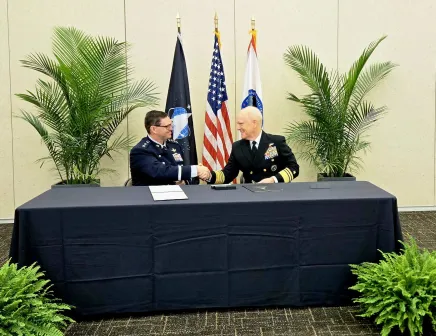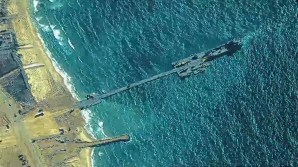Space Force plans to kick off 3 additional commercial reserve fleet ‘pilots’ in 2025

COLORADO SPRINGS, Colo. — Now that the Space Force’s Commercial Augmentation Space Reserve (CASR) is officially in its “pilot phase,” the service intends to ramp up the program and sign contracts for even more mission areas this year, according to a Space Force official.
Col. Rich Kniseley, director of the Commercial Space Office (COMSO), told reporters Thursday that the service will stand up CASR pilots across three mission areas in 2025. One program will focus on small launch and is anticipated to kick off before the end of fiscal 2025, while the other two — satellite communications, and tactical surveillance, reconnaissance and tracking — are expected to be ready by December, Kniseley said.
The program’s growth comes just two years after the Space Force first conceived it as its own version of the Air Force’s Civil Reserve Air Fleet. Under CASR, the service can contract space-based services from commercial vendors during peacetime, which could then be used to augment and support military operations in the event of crisis or conflict.
In March, the Space Force launched CASR’s pilot phase when it awarded contracts to four commercial vendors to provide space domain awareness capabilities. The agreements cover an initial three-month period of performance and include peacetime and pre-priced surge capabilities, as well as the ability to conduct wargames with vendors, Kniseley said.
“What that allowed us to do is to start exercising some of the processes while we are still working in the background with some of the more challenging aspects of CASR, whether that’s prioritizing capabilities for US government use [or] denial of service,” he said during a media roundtable at the annual Space Symposium.
For the small launch pilot, the office will look to commercial launch providers already part of the Space Force’s Orbital Services Program-4 (OSP-4) program, which focuses on fast-turnaround launches of small payloads, Kniseley said. COMSO is partnering with Space Systems Command’s Assured Access to Space (AATS) directorate and the Space Safari program office for the pilot.
“It’s formulating a framework around launch, but small launch specifically,” Kniseley said. “Think of a call-up at a given point and some of the ongoing pieces. It will be a tabletop exercise more than anything, instead of an operational call.”
The pilot will align closely with the Space Force’s ongoing Tactically Responsive Space (TacRS) initiative that aims to improve the service’s ability to respond to new threats on-orbit, such as by reducing time taken to launch payloads or prepositioning assets in space, Kniseley said.
He added that while the small-launch effort isn’t quite ready to serve as a mechanism for TacRS, the program’s managers are learning from COMSO’s pilot — including supply chain management and how it’s building the contracts to “surge and scale.”
Similarly, COMSO is looking to leverage the pool of vendors under the Space Force’s larger Tactical Surveillance, Reconnaissance and Tracking (TacSRT) program for its upcoming surveillance, reconnaissance and tracking pilot, Kniseley said.
Broadly, the service’s TacSRT effort allows combatant commanders to quickly and directly purchase unclassified data from imagery and sensors collected by commercial satellites — but COMSO’s pilot will be framed through the CASR concept.
“What if we were to put a company on to provide X number of products during peacetime? If I want to scale that up, and as things go on and I’m going to be getting more and more requirements from the combatant commands — that’s the type of model and framework I’m seeing for that,” he said.
And while Kniseley didn’t provide specifics for the service’s SATCOM pilot plans, he said the mission area was the focus for the office’s first CASR wargame completed recently. The event was critical, as it gave COMSO a slew of action items and topics it needs to work on with commercial vendors as it builds out the program.
During the wargame, Kniseley exercised a forceful activation of CASR — representing a real-life scenario in which industry would be required to turn off capabilities to other customers to fully support U.S. military operations. The event allowed companies to coordinate together, while also giving them the opportunity to think about how they would work with their investors and other customers.
“I viewed that as a complete success because it wasn’t 100% successful,” Kniseley noted. “What I wanted to do was have nothing but commercial capability or vendors in there, and I wanted to start exercising the framework for CASR. I really wanted to key in on some of the aspects that we have questions on, and to have that dialog back and forth.”
As COMSO prepares to launch the three new pilot programs, the office is also conducting a study with the Office of the Under Secretary of Defense for Policy and the legal community on financial protection options for CASR vendors, Kniseley said. The results of the study should be released in the next few months to provide guidance on how the office plans to proceed, he added.
Overall, Kniseley said his office’s efforts to integrate commercial capabilities on a larger scale have garnered positive support from Congress. Before receiving $40 million in funds from the yearlong continuing resolution passed in March, lawmakers added $50 million to the 2024 National Defense Authorization Act (NDAA) for commercial space services, which was critical to getting COMSO initiatives like CASR off the ground.
He also pointed to President Donald Trump’s recent executive order calling for prioritization of commercial capabilities within the Defense Department as validation for COMSO’s work.
“[When] I look at the executive order, I look at it more as an exclamation point on a lot of the things that we’re doing,” he said. “But it will require additional budget. It will also require additional resources, and that usually means people, as well.”






